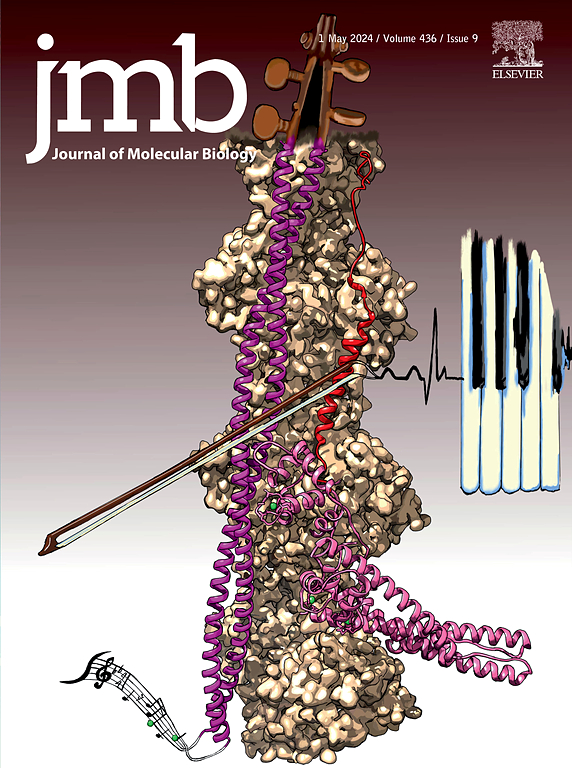转运RNA和tRNA假尿嘧啶合酶中的假尿嘧啶修饰。
IF 4.5
2区 生物学
Q1 BIOCHEMISTRY & MOLECULAR BIOLOGY
引用次数: 0
摘要
在转移RNA中发现的各种修饰中,假尿嘧啶在所有生物体中发生的频率最高,也存在于其他RNA物种中,包括核糖体、信使RNA、小核、小核仁和转移信使RNA。自1978年第一个编码tRNA伪尿嘧啶合成酶(truA)的基因被发现以来,许多伪尿嘧啶合成酶已经被鉴定出来,其中一些特异性地作用于tRNA中的一个位点,而另一些则作用于多个位点。此外,一些酶不仅能催化tRNA的假尿嘧啶修饰,还能催化核糖体RNA和小核RNA或信使RNA的假尿嘧啶修饰。假尿嘧啶在tRNA中的功能是多种多样的,从有助于稳定tRNA结构到在精确的蛋白质合成中发挥重要作用(在某些情况下缺乏会导致移码)。一些假尿嘧啶合成酶也起RNA伴侣的作用。本文综述了6个假尿嘧啶合成酶家族的反应机理和功能,包括结构域结构、基序和靶尿嘧啶碱基的异同。我还描述了个别酶,并强调最近发现的假尿嘧啶/假尿嘧啶合成酶与病毒感染和人类疾病之间的联系。本文章由计算机程序翻译,如有差异,请以英文原文为准。

Pseudouridine Modifications in Transfer RNA and tRNA Pseudouridine Synthases
Among the various modifications found in transfer RNAs, pseudouridine occurs the most frequently in all organisms and is also found in other RNA species including ribosomal, messenger, small nuclear, small nucleolar, and transfer-messenger RNA. Since the first gene encoding a tRNA pseudouridine synthase (truA) was discovered in 1978, many pseudouridine synthases have been identified, some of which are specific for one site in tRNA, while others act at multiple sites. Furthermore, some enzymes catalyze pseudouridine modification of not only tRNA but also ribosomal RNA and small nuclear RNA or messenger RNA. The functions of pseudouridine in tRNA are diverse, from contributing to the stabilization of tRNA structure to having an essential role in accurate protein synthesis (deficiency induces a frameshift in some cases). Some pseudouridine synthases also function as RNA chaperones. In this review, I summarize the reaction mechanism and functions of pseudouridine synthases with reference to the six pseudouridine synthase families, including similarities and variations in domain structures, motifs, and target uracil bases. I also characterize individual enzymes and highlight recently revealed links between pseudouridine/pseudouridine synthases and viral infections and human diseases.
求助全文
通过发布文献求助,成功后即可免费获取论文全文。
去求助
来源期刊

Journal of Molecular Biology
生物-生化与分子生物学
CiteScore
11.30
自引率
1.80%
发文量
412
审稿时长
28 days
期刊介绍:
Journal of Molecular Biology (JMB) provides high quality, comprehensive and broad coverage in all areas of molecular biology. The journal publishes original scientific research papers that provide mechanistic and functional insights and report a significant advance to the field. The journal encourages the submission of multidisciplinary studies that use complementary experimental and computational approaches to address challenging biological questions.
Research areas include but are not limited to: Biomolecular interactions, signaling networks, systems biology; Cell cycle, cell growth, cell differentiation; Cell death, autophagy; Cell signaling and regulation; Chemical biology; Computational biology, in combination with experimental studies; DNA replication, repair, and recombination; Development, regenerative biology, mechanistic and functional studies of stem cells; Epigenetics, chromatin structure and function; Gene expression; Membrane processes, cell surface proteins and cell-cell interactions; Methodological advances, both experimental and theoretical, including databases; Microbiology, virology, and interactions with the host or environment; Microbiota mechanistic and functional studies; Nuclear organization; Post-translational modifications, proteomics; Processing and function of biologically important macromolecules and complexes; Molecular basis of disease; RNA processing, structure and functions of non-coding RNAs, transcription; Sorting, spatiotemporal organization, trafficking; Structural biology; Synthetic biology; Translation, protein folding, chaperones, protein degradation and quality control.
 求助内容:
求助内容: 应助结果提醒方式:
应助结果提醒方式:


